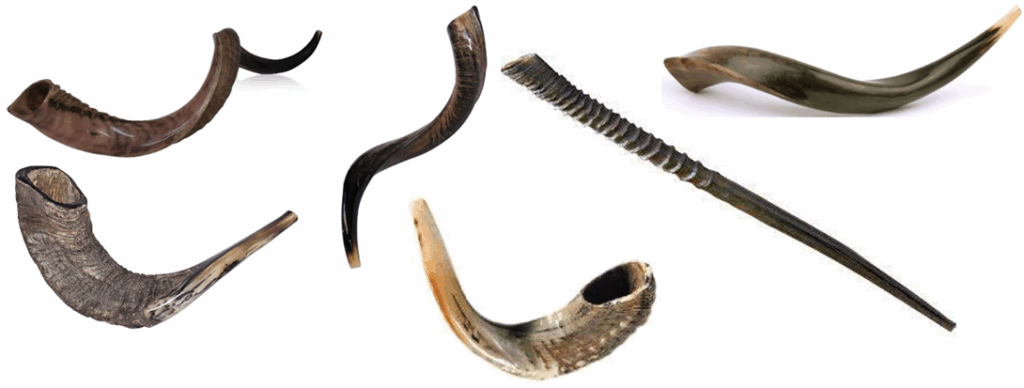
Nitzavim (ניצבים – Standing)
Deuteronomy 29:9–30:20 & Isaiah 61:10–63:9
Moshe gathers all of Israel to renew the covenant with the Eternal. This solemn moment emphasizes the unity of the people, as each individual is called to stand before God.
Rosh Hashanah (ראש השנה – Beginning of the Year)
Yom Teru‘ah (יום תרועה – Day of Sounding)
Genesis 21:1–34; 22:1–24 • Numbers 29:1–6 • 1 Samuel 1:1–2:10 • Jeremiah 31:1–19
On Rosh Hashanah, the biblical readings evoke the birth and binding of Yitzḥak, the prayer of Ḥannah, and the tears of Yirmiyahu. The sound of the shofar recalls the ram substituted for Yitzḥak, but also the cries of prayer and the calls for mercy. It embodies the breath of covenant and spiritual awakening.
Deuteronomy 29:9
אַתֶּם נִצָּבִים הַיּוֹם כֻּלְּכֶם, לִפְנֵי ה׳ אֱלֹהֵיכֶם
You are all standing today before the Eternal, your God
Numbers 29:1
יוֹם תְּרוּעָה, יִהְיֶה לָכֶם.
It shall be for you a day of sounding the shofar.
Shofarot Israel – Bar-Sheshet Ribak :
The Bar-Sheshet family traces its lineage back to 14th-century Spain with Rabbi Yitzḥak Bar-Sheshet Barfat[¹]. According to family tradition, one of his descendants began working with horn to make utilitarian objects, eventually specializing in crafting shofars.
After the expulsion of Jews from Spain in 1492, the Bar-Sheshet family settled in Morocco, where the craft of shofar-making was preserved for generations. In 1947, Meir Bar-Sheshet boarded the Exodus[²] en route to Eretz Israel, but the ship was turned away by British authorities, and Meir was interned in a camp in Germany. There, on the eve of Rosh Hashanah, he crafted his first shofar. In 1948, he succeeded in immigrating to Israel and, reconnecting with his ancestral craft, founded a workshop in Haifa.
On the Ribak side, the artisanal tradition begins in Włodawa, Poland, with Yaakov Rossman. Known for his expertise in hornwork, he gained recognition for the quality of his shofars. In 1927, he immigrated to Mandatory Palestine and settled in Tel Aviv, where he became the first artisan to craft shofars in the city. With no direct descendants, he passed his knowledge to his cousin Avraham Ribak, who continued the workshop and trained his son Eli Ribak.
In the 1980s, Eli Ribak and Tsvi Bar-Sheshet, son of Meir, founded Shofarot Israel – Bar-Sheshet Ribak, which is now recognized worldwide as a leading name in handcrafted shofars.
The shofars produced in this workshop are made from the horns[³] of kosher animals, such as ram, kudu, ibex, oryx, and eland. Each horn is softened by heat, hollowed, shaped, drilled at the mouthpiece, polished, and carefully finished by hand. Some models are silver-plated, painted, or engraved according to client preferences. The entire process is fully artisanal, using tools often designed by the craftsmen themselves, in strict accordance with the laws of kashrut and halakhic requirements.
[¹] Yitzḥak Bar-Sheshet Barfat (יצחק בר ששת ברפת), known by the acronym Ribash (ריב״ש), was born in 1326 in Valencia and died in 1408 in Algiers. He was one of the greatest halakhic authorities of his time, authoring hundreds of responsa and serving rabbinic roles in the communities of Barcelona, Zaragoza, and Algiers. He remains a major figure in medieval Sephardic Judaism, known for the rigor of his reasoning.
[²] The President Warfield, an American steamship, was reassigned in 1947 by Mossad LeAliyah Bet to transport over 4,500 Holocaust survivors to Mandatory Palestine. Renamed Exodus 1947 at sea, it was intercepted by the British navy before reaching Haifa. Three passengers were killed, and the survivors were interned in camps in Germany. The incident sparked international outrage and contributed to growing support for the creation of the State of Israel.
[³] Cow horn is not used to make a shofar, as it is referred to in the Torah by the term keren (קרן) rather than shofar (שופר). According to the Talmud (Rosh Hashanah 26a), this terminological distinction excludes it from ritual use. Additionally, some commentators associate it with the sin of the golden calf, reinforcing its unsuitability for sacred sounding on Rosh Hashanah.